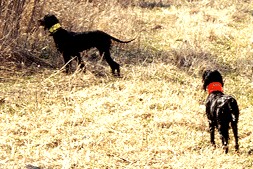|
|

|
|
Brace
When this term is used in the context of upland hunting, it retains its much older meaning. In Latin, bracchia is the plural form of bracchium, which is an arm or a branch. Two bracchia, then, are a pair of arms. The term found its way through early Middle French and on to Middle English to refer to the two pieces of a clasp (such as on a cloak), and eventually to a pair of pretty much anything. Handed down from hunters in the UK, this noun is still used in the US to refer to a pair of dogs that run and hunt together. Most handlers find that running more than two dogs at a time poses risks and distractions that take away from hunting success. Hunters need to be aware of both their own dog's position and performance and that of their dog's bracemate. The dogs need to be able to work as a team (such as when backing each other), and handlers need to think of the brace as a single unit. Perhaps that's why the term has stayed in use: when one says, "the dogs ran well," the image that immediately comes to mind is of two dogs working the field. But when you hear, "that brace handled the chukar perfectly," you're picturing a well-coordinated team, working together. Browse The EU Here: A-C | D-F | G-I | J-L | M-O | P-R | S-V | W-Z |
|
^Top | Home | About UplandLife.com | Contact Us | Advertising/Listings | Privacy / Policies | Site Map Entire contents copyright © 2024 UplandLife.com, All Rights Reserved. Content Technology From NorseCode. |
